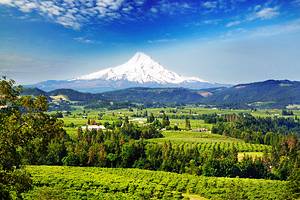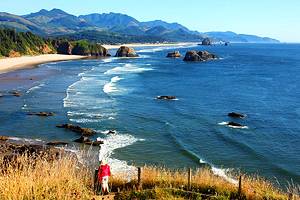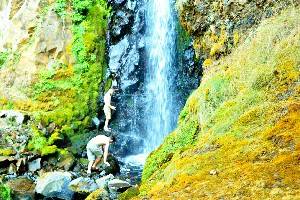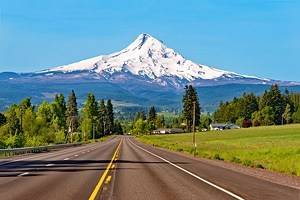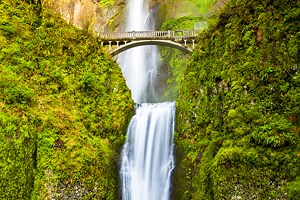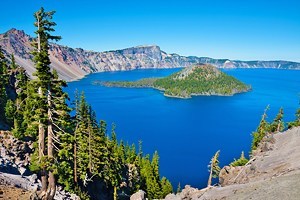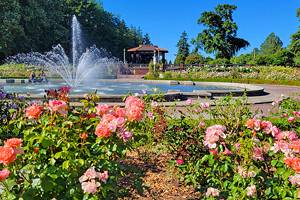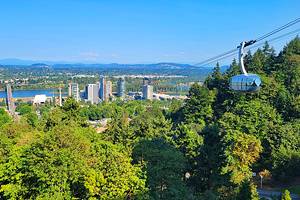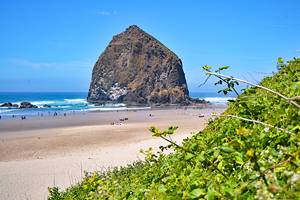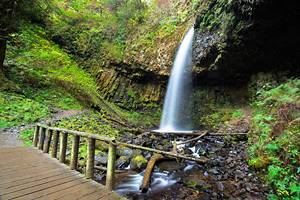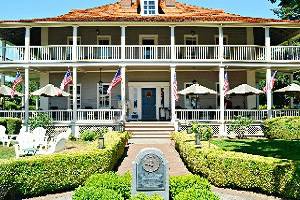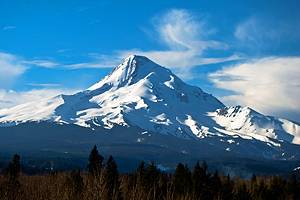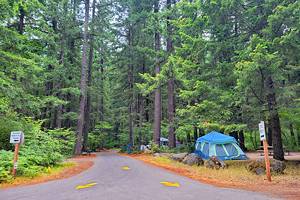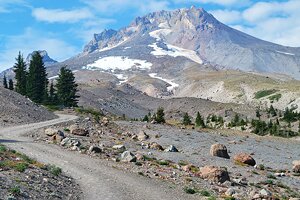Hiking Trails near Portland, Oregon
Author Brad Lane lives in Portland and enjoys hiking the local trails.
Portland is an urban oasis with many hiking trails in and around the city. The largest urban forest in the country occupies over 5,000 acres in Portland, aptly named Forest Park. And outside of the 80-plus miles of trails here, several other areas for hiking dot the city.

Trekking on trails is part of the Portland lifestyle. Many of the best hiking trails within city limits lead right to some of Portland's top attractions. Historic mansions, world-famous rose gardens, and more than one stunning waterfall are accessible from trailheads in Portland, making it easy for visitors to lose themselves in nature without ever really leaving the city.
Hiking trails on the outskirts of Portland offer even more alluring landscapes to explore. The Columbia River Gorge directly north of the city offers several hiking trails ending at dramatic waterfalls. Public transportation is available to nearly all trailheads within and near the city.
Plan your adventures with our list of the best hiking trails near Portland.
- Lower Macleay Park to Pittock Mansion Hike
- Blue Loop Trail, Mount Tabor Park
- Washington Park Loop Hike
- Maple Trail Loop, Forest Park
- Eagle Creek to Punch Bowl Falls, Columbia River Gorge
- Marquam Trail to Council Crest
- Latourell Falls, Columbia River Gorge
- Mountain View Trail, Powell Butte Nature Park
- Tryon Creek State Natural Area Trail System
- Bluff Trail, Oaks Bottom Wildlife Refuge
- Four T Trail
- Map of Hiking Trails near Portland, Oregon
- Portland, OR - Climate Chart
Lower Macleay Park to Pittock Mansion Hike
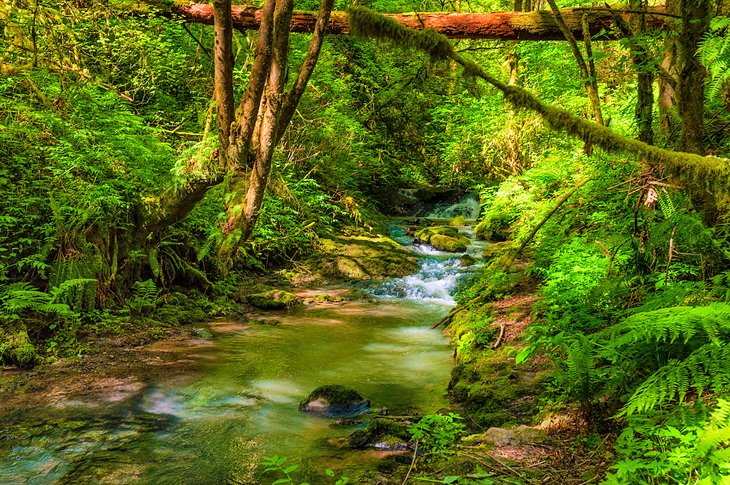
Highlights: Classic Portland hike leading to historic Pittock Mansion, which overlooks the city
The trek from Lower Macleay Park to Pittock Mansion is one of the most defining urban hikes of Portland. The route takes hikers from city streets into a quiet forest and to an iconic landmark of Portland history with a five-mile round trip.
Beginning at the Lower Macleay Park Trailhead, accessible by public transportation, the trail immediately dives into the deep wonders of Forest Park. Here, the trail connects with the Wildwood Trail before ascending to Upper Macleay Park. Lush vegetation and many green shades define the surroundings as the trail gains approximately 900 feet of elevation along the route.
A recommended detour along the roughly 2.5-mile trek up includes a quick stop at the Portland Audubon Society, where hikers can visit the current wildlife residents being rehabilitated. From the Audubon Society, the Pittock Mansion parking lot and historic manor are only a short distance away.
Once home to the family of Henry and Georgiana Pittock, the Pittock Mansion was built in 1914 and purchased by the city in 1964 with major support from the Portland community. Contributing to the success of The Oregonian newspaper, Henry Pittock and his wife were both influential members of Portland society well before the city became the major cultural center it is today.
The Pittock legacy is explored in more detail with a guided tour of the mansion, available by appointment. But the impressive facade and landscaped gardens of Pittock Mansion make it a worthy hiking destination without the guided tour, including the great view overlooking the city from the backyard.
Blue Loop Trail, Mount Tabor Park
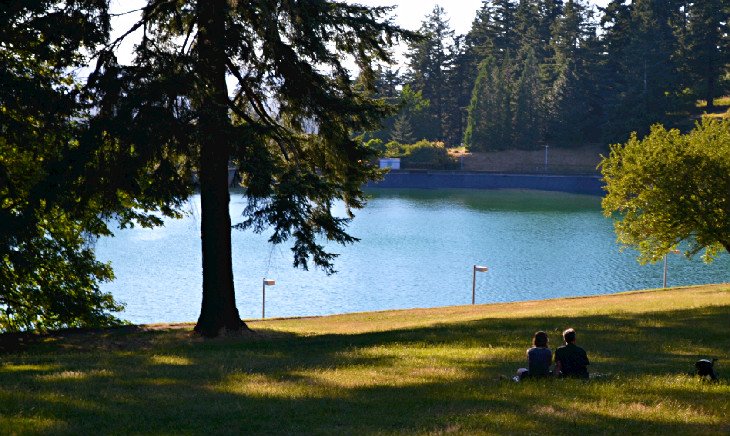
Highlights: Ancient cinder cone with elevated views and landscaped parkland
On Portland's east side, the extinct volcanic cinder cone known as Mount Tabor is a popular park for all sorts of recreation. Hikers, cyclists, and soap box derby drivers often populate the park, alongside picnickers, playground users, and yard game enthusiasts.
Mount Tabor Park encompasses just under 200 acres and two water reservoirs and is easy to explore. Several trails at the park connect and sprawl throughout the public space. And for those that like some direction, the Blue Loop is a popular route to follow.
The trail extends just over three miles and circles the park, including both reservoirs. Portions of the trail include long sets of stairs that ultimately lead to the summit. The route is a loop, and blue arrows designate the preferred counterclockwise direction of travel.
Other designated hiking trails at Mount Tabor include the Red and Green Loop Trails, both offering a less steep route to follow. Many of the trails pass by the iconic attractions that define Mount Tabor Park alongside great overlooks of the city to the west.
Washington Park Loop Hike
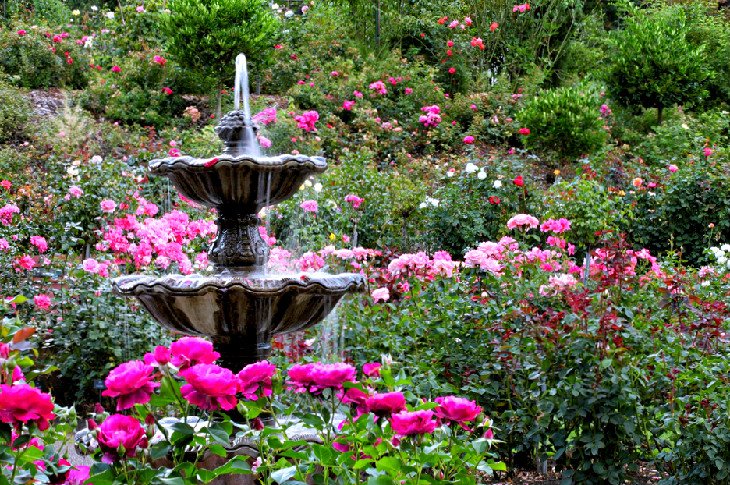
Highlights: Quintessential Portland hike connecting several top tourist attractions in Washington Park
Washington Park is the city's centerpiece natural space. It features top Portland attractions like the Hoyt Arboretum, International Rose Test Garden, and the Oregon Zoo. With many cultural attractions worth some attention, one of the best ways to explore the 400-acre park is with a hiking loop, using the start of the 30-plus-mile Wildwood Trail.
Beginning near the Oregon Zoo, the trail quickly passes by the entrance to the Vietnam Veterans Memorial before heading up to the Hoyt Arboretum. With topside views of the many different trees comprising the arboretum, the Wildwood trail continues ascending to the Portland Japanese Gardens.
To make the trek a loop, a cut-off trail passes by historic tennis courts and descends its way back to the park's trailhead and south side. This looped route totals nearly four miles in length. To really take advantage of everything this hike leads to, it's highly recommended to take at least half the day to hit the trail and explore whatever catches some attention.
The Washington Park Loop trail has plenty of cultural attractions to encourage a leisurely pace. Other attractions that encourage side trips include an archery range, a children's museum, and a wide variety of memorials and statues.
Maple Trail Loop, Forest Park
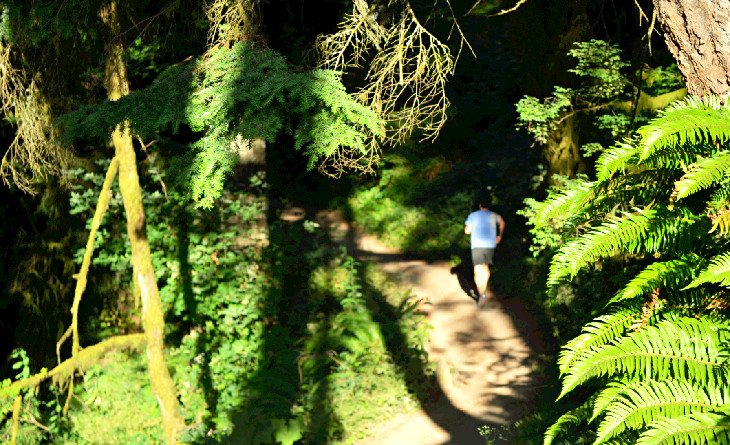
Highlights: Dives deep into the dense nature of Forest Park, variable distances available
Encompassing over 5,000 acres within Portland's northwest city limits, Forest Park is one of the largest urban forests in the country. It's easily accessible by public transportation and this urban getaway invites a true escape from the hustle and bustle of the sidewalks and streets nearby. Laced throughout the park are over 80 miles of trails, forest roads, and fire lanes to explore,
Numerous trail junctions within Forest Park invite customizable hiking endeavors. The 30-plus mile Wildwood Trail serves as the main corridor and usual trail connector. With such big acreage, some trails in Forest Park see far less traffic than others. Other trails like the Maple Loop, however, see much more foot traffic and are popular for first-time visitors and long-term Portlanders alike.
From the Lower Saltzman Trailhead, the Maple Loop immediately introduces users to the tallest trees of Forest Park, including big-leaf maples, Douglas-firs, and red alders. The trail crosses bridges and gullies from there, connecting with either the Maple Trail, Leif Erickson Trail, or Wildwood Trail for a variable-distance loop. The Maple Trail and Wildwood Trail Loop add up to an 8.4-mile loop with over 1,000 feet of elevation gain.
Whichever direction you head, the tall landscape becomes denser the farther you travel. While signposts are prevalent throughout the park, it's recommended to bring along a map or detailed reference guide.
Eagle Creek to Punch Bowl Falls, Columbia River Gorge
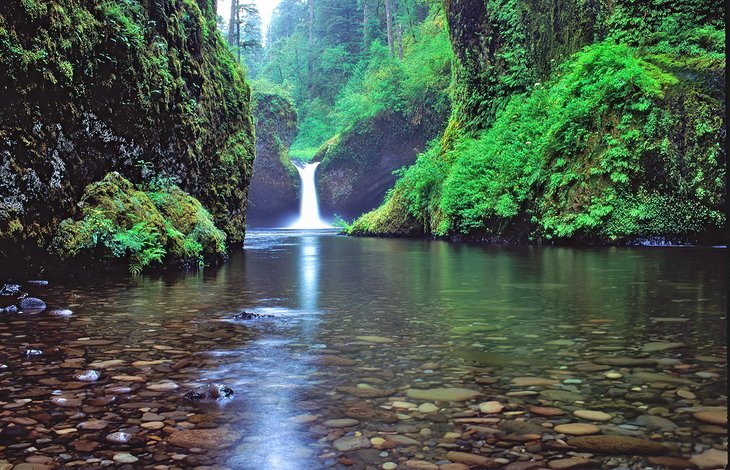
Highlights: Stunning hiking trail with steep ledges and iconic waterfalls
The Eagle Creek Trail is an iconic hike in the Columbia River Gorge National Scenic Area. Its construction dates back over a century, and its most recent history pertains to the 2017 Eagle Creek Fire that ripped through the area. After much volunteer effort, the trail re-opened in 2021, but some of the scars remain.
The entire trail spans 13.1 miles from the Columbia River Gorge up to the Pacific Crest Trail and the flanks of Mount Hood. However, most visitors opt for the approximately 4.2-mile round-trip hike to Punch Bowl Falls, one of the top waterfalls near Portland. This sometimes crowded waterfall warrants the fanfare, with a beautiful plunge into a swimming pool.
More natural attraction awaits hikers that want to go farther. Eagle Creek is also home to an iconic tunnel waterfall, where hikers proceed behind the water. Steep drop-offs line much of the trail leading to the creek. Some handrails are in place in the most exposed areas, but those cautious of heights or traveling with wandering children will want to proceed with caution.
Eagle Creek is a popular trail, especially come summer weekends. An approximate 70 parking spaces are available between three different lots, with the most abundant parking at the Cascade Salmon Hatchery nearby. Parking can be a real challenge. It's best to arrive at the trailhead early to secure a spot.
Marquam Trail to Council Crest

Highlights: Uphill hike leading to elevated views on the east side of the city
Council Crest Park reveals a rich horizon of Cascade Mountain peaks. Council Crest is one of Portland's highest points at just over 1,000 feet in elevation, and once was the site of an early 20th-century amusement park. While it's possible to drive to this still-popular center of community attraction, it's much more rewarding to hike your way to the top.
One of the most popular routes up to Council Crest begins at the Marquam Nature Park Shelter. The nature park is a common jumping-off point for other hikes in the area. The trail to Council Crest from Marquam is a consistently uphill, two-mile trek. It's over 1,100 feet of elevation gain to reach the top. Hikers make their way through a dense forest punctuated by neighborhood homes and a few road crossings along the way.
Sunset is a great time to arrive at Council Crest to enjoy the view, though hikers will want to be sure to leave themselves enough light to make it back down to the nature park shelter. At the top of Council Crest, alongside great views, a community piano awaits during the summer for anyone who knows their way around the keys.
Latourell Falls, Columbia River Gorge

Highlight: Closest waterfall to Portland in the Columbia River Gorge
Latourell Falls plunges over 200 feet to create an impressive display of moving water within the Columbia River Gorge. This fantastic waterfall is accessible via the Historic Columbia River Highway. It's just over a mile and 600 feet of elevation gain to reach the popular waterfall viewpoint from Guy Talbot. The trail makes a loop for a total 2.5-mile journey.
The trail begins from a popular and sometimes crowded trailhead. A recommended approach to the falls involves parking at Guy W. Talbot State Park just below the main trailhead parking area. Here, a vast picnic area makes for a great break before or after hiking.
Latourell Falls is one of the most scenic waterfalls in Oregon, and it's also the closest waterfall in the Columbia River Gorge to Portland, making it a great starting point for all-day exploring of this scenic region.
Mountain View Trail, Powell Butte Nature Park

Highlights: Vast hiking destination on the city's east side with several panoramic sunset views
Powell Butte is an extinct cinder cone volcano on the east side of the city near Gresham, surrounded by many excellent trails to explore. It's open to hikers, cyclists, and horse riders. The park encompasses over 600 acres and many great vantage points overlooking surrounding Cascade peaks.
One of the best trails to explore the scenic attraction of Powell Butte is the aptly named Mountain View Trail. Beginning near the parking area and visitor center, the Mountain View Trail takes an easy approach up to the ridgeline before evening out for constant views. On clear days, a few of the prominent peaks seen on the horizon include Mount St. Helens, Mount Adams, and most predominantly, Mount Hood.
After appreciating the views, hikers on Mountain View Trail can connect with the Wildhorse Trail to make a 1.3-mile loop. This route is rated easy and accommodates most hiking abilities. The Mountain View Trail also connects to the park's vast network of multi-use trails for a bigger adventure.
Tryon Creek State Natural Area Trail System

Highlights: Family-friendly trails and nature center, also popular with horse riders
Comprised of over 650 acres of wooded and second-growth forest environments, Tryon Creek State Natural Area is an easy escape south of the city. Visitors in downtown Portland can reach Tryon with a 30-minute drive or 45-minute ride on public transportation. Upon arriving, visitors have over eight miles of routes to choose from.
Several trails branch out from the main parking area at Tryon. These paths lead to various bridge crossings, an interpretive Nature Center, and near-guaranteed wildlife sightings. A few of the trails have minimal elevation gain, but many of the routes require a little climbing. Tryon is a popular place for young families and little explorers.
Horse riders also come to Tryon to get some riding in near city limits. The natural area features 3.5 miles of packed gravel trails for equestrians, as well as a designated parking area. These trails are also open to hikers.
The 0.3-mile Ruth Pennington Trillium Trail is a popular and universally accessible route in Tryon, including with it an array of interpretive information about the surrounding environment.
Bluff Trail, Oaks Bottom Wildlife Refuge

Highlights: Hiking-only trail starting in the Sellwood neighborhood, full of avian wildlife
A collection of paved paths and dirt trails lend easy access to this landfill turned wildlife refuge on the city's southern edge. Alongside hundreds of species of birds, Oaks Bottom Wildlife Refuge is also popular for hikers and nature enthusiasts. The hiking-only Bluff Trail is the main exploration corridor, with most adventures starting at the southern end of the refuge at Sellwood Riverside Park.
The trail navigates north on an easy grade beneath various trees, which support the refuge's diverse wildlife. Affording great views and observation points along the way, the trail skirts along an open water area before reaching a junction with the Springwater Corridor. The entire route is very flat and easy to follow the entire way.
The Springwater Corridor is one of Portland's longest cycling paths. To complete a loop back to Sellwood Park, pedestrians should hop on the Springwater Corridor, watching out for faster-moving cyclists, and head back south to complete a 2.3-mile loop.
Four T Trail

Highlights: Excellent urban adventure utilizing all of Portland's public transportation
The Four T Trail is a unique, self-guided hiking endeavor that tours some of Portland's best sights. The route incorporates the train, trolley, tram, and hiking trails, lending to its name. It's well-signed and popular with tourists and residents alike.
The trail's official start begins at the Pioneer Courthouse Square. From this historic area of the city, Four T followers hop on the MAX light rail to the Oregon Zoo. After spending time exploring the Oregon Zoo, the next step of the journey involves hiking 1.3 miles up the Marquam Trail to Council Crest (see above).
From Council Crest, 4T signs lead the way to the Oregon Health and Science University campus. It's easy to catch the Portland Aerial Tram downhill from campus while appreciating the views of the Willamette River. The tram is free to ride downhill and just under $5 for round-trip service.
At the Tram's terminus, users hop aboard a Portland Streetcar to complete the loop back to Pioneer Square. The streetcars provide service every 15 minutes. In total, this urban trail offers a rewarding way to experience the city without ever using a personal vehicle.
Map of Hiking Trails near Portland, Oregon
Portland, OR - Climate Chart
| Average minimum and maximum temperatures for Portland, OR in °C | |||||||||||
| J | F | M | A | M | J | J | A | S | O | N | D |
| 8 3 | 10 4 | 13 5 | 16 7 | 19 9 | 23 12 | 26 14 | 26 14 | 23 13 | 17 9 | 11 6 | 8 3 |
| PlanetWare.com | |||||||||||
| Average monthly precipitation totals for Portland, OR in mm. | |||||||||||
| 159 | 129 | 115 | 79 | 63 | 41 | 19 | 25 | 48 | 86 | 162 | 172 |
| Average minimum and maximum temperatures for Portland, OR in °F | |||||||||||
| J | F | M | A | M | J | J | A | S | O | N | D |
| 46 37 | 50 39 | 56 41 | 61 44 | 67 49 | 73 53 | 79 57 | 79 58 | 74 55 | 63 48 | 51 42 | 46 37 |
| PlanetWare.com | |||||||||||
| Average monthly precipitation totals for Portland, OR in inches. | |||||||||||
| 6.2 | 5.1 | 4.5 | 3.1 | 2.5 | 1.6 | 0.8 | 1.0 | 1.9 | 3.4 | 6.4 | 6.8 |
The best time to visit Portland for hiking is in the summer, including July, August, and the edges of June and September. This time of year offers the warmest temperatures and longest days, and the city is absolutely abuzz with sunshine throughout the season. This is also the driest time of year, leaving the trails in the best conditions.
Residents say that summer doesn't start in Portland until the 4th of July. This is partially true, especially as the long spring season spans throughout April, May, and into June. This spring season is still a wonderful time to visit, as the city's parks and gardens start to come back to life. Bring rain-resistant gear this time of year. Some trails may be closed due to mud.
Summer extends into September in Portland, with warm temperatures often defining the beginning of the month. New colors come into the landscape by the end of September, and autumn comes into full force by October. Expect consistent rain and clouds on the forecast by the end of October.
More Related Articles on PlanetWare.com
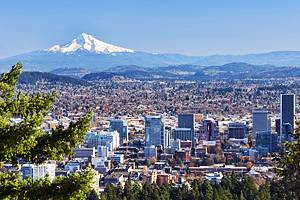
More in Portland: For campers, all the best campgrounds near Portland can be found in stunning natural environments close to the city. After exploring Portland, you might be in the mood for a little retreat away from the city. If so, our guide to the best day trips and weekend getaways from Portland can send you in the right direction.
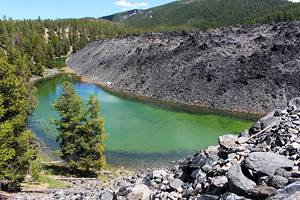
Adventures in Oregon: As well as hiking trails and campgrounds in Oregon, interested explorers can find an array of scenic waterfalls, relaxing hot springs, and plenty of amazing weekend getaways. For oceanside fun, set your sights on the Oregon coast, and particularly Oregon's beautiful beaches.
For avid hikers, the hiking trails near Bend will also surely please, and campers looking to pitch a tent or set up an RV should have a look at our list of the best campgrounds of Hood River.


